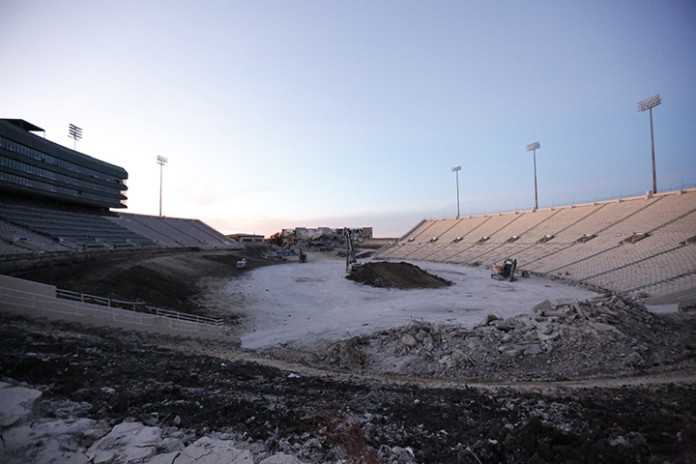Floyd Casey Stadium is undergoing demolition and many people are mourning the loss of this former home of the Baylor Bears.
The work began in January and is expected to end in late spring or early summer.
The stadium is being torn down in order to fulfill the $35 million Tax Increment Financing (TIF) grant given to Baylor for the building of McLane Stadium. The city of Waco agreed to finance the project with the promise of use of the land where Floyd Casey currently stands.
According to the agreement, the Floyd Casey Stadium either had to be torn down or another use for it had to be found that was of equal value to the city of Waco.
“Anything you might hold at that venue, people are going to want to come to McLane at this point,” said Brian Nicholson, vice president for operations and facilities management, said. “There were no financially viable alternatives for that property.”
The project was originally set to end in January, but a six-month extension was granted by the city.
“The fear could have been that we would get TIF funds and that we would leave Floyd Casey standing,” Nicholson said. “You know if you go around town and see old dilapidated structures… They didn’t want that and we weren’t going to do that.”
Loyd D. Nabers Demolition LLC is leading the charge on the demolition. The first step of demolition was taking care of environmental remediation before the stadium was stripped of any recyclable materials, according to Nicholson. This past week, they began to tear out concrete.
Professor Maxey Parrish, senior lecturer of Journalism, Public Relations and new media, attended his first football game at Floyd Casey. He then went on to attend games as a student at Baylor and work for the sports department for 19 years.
“I attended, in the neighborhood, about 200 games there, about half as a fan and half an employee,” Parrish said. “It’s probably safe to say I spent about as much time there as anybody for a very long time.”
The architecture of the building was one of its best qualities, Parrish said, but the stadium had severe issues with foundation and safety from the beginning. The dated stadium was the home of the Baylor football team for over 60 years. After many attempts to patch it up, the move to McLane was necessary, Parrish said.
“It’s on its way to becoming an eyesore and just detracting from Waco. If there’s a better use for that land, then let’s utilize it. It’s like anything else, you get nostalgic because you invest so much of your life into that place, but it’s time,” Parrish said.
San Marcos, senior, Kody Banda, is the male captain on coed cheer squad and was on the field during the last year Floyd Casey was in use.
“The very last game was freezing. The sheer fact that so many people stayed… It set the groundwork for me being a die-hard Baylor fan, considering it was my first year here,” Banda said.
Banda shares his memories with fellow classmates and teammates and hopes that Floyd Casey will never be forgotten by future students and Baylor alumni.
“I believe it’s served its purpose and it laid the foundation for Baylor athletics and football. We’re bringing what Floyd Casey gave us back to campus, back to McLane,” Banda said. “The surrounding neighborhood isn’t campus, so it can serve a bigger purpose for the citizens of Waco.”
Waco will use the property for the development of the city, most likely for housing or commercial building.
Baylor received a five-acre plot of land for the deconstruction of the stadium in November 2015. A proposal has been sent to the city of Waco requesting the creation of a sports medicine and exercise science building. So far no word has been given on the proposal.






